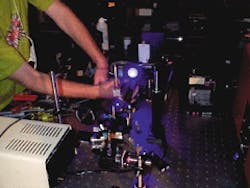Palo Alto, CA--Attendance at the annual meeting of the Center for Nonlinear Optical Materials (CNOM; Stanford University, Palo Alto, CA) in September exceeded attendance at the 1997 meeting, despite a scheduling conflict with the Conference on Lasers and Electro-Optics in Europe (Glasgow, Scotland) and the fact that the center had just completed its first year without federal funding. Strong private-sector support from the center`s affiliated companies has kept the CNOM afloat economically, and presentations from both industrial and academic participants focused on transitioning nonlinear optical materials out of the R&D laboratory and into the commercial marketplace. A key development announced at the meeting is expected to provide a high-power blue-output laser source within the next two years.
Walt Bosenberg of Lightwave Electronics (Mountain View, CA) gave the keynote plenary address on quasi-phase-matching (QPM) in commercial applications. Bosenberg`s talk focused primarily on the overlap between present technical capabilities of QPM technology and needs of the laser marketplace, as well as barriers that have impeded widespread use of QPM in large commercial markets.
Commercial barriers
A key barrier to commercialization of QPM materials has been the high level of green-induced infrared absorption (GRIIRA), which increases the probability of crystal damage on second-harmonic-generation in lithium niobate (LiNbO3) of green light from infrared. The list of other barriers includes various unpredictable or uncontrollable problems, such as photoinduced index changes and photorefraction.
"These are things that researchers have an easy time getting around, because they are only using one piece and they look for the sweet spot in the piece and write a paper on it," Bosenberg said. "But those of us who are producing commercial products require a great deal more homogeneity from any source that we`d want to use."
Bosenberg also said that commercial needs tend more toward the visible and ultraviolet ends of the spectrum than the infrared.
Several presentations at the meeting addressed points raised in the plenary talk. Among them were results obtained in the laboratory of CNOM director Robert Byer and presented by Robert Batchko indicating that GRIIRA could be controlled in commercial-grade LiNbO3 using a temperature-annealing process. Batchko also presented results obtained just prior to the meeting describing his group`s generation of blue light based on a new poling technique for commercial-grade LiNbO3.
The temperature-annealing method for reducing GRIIRA, described by Batchko, consisted of annealing the crystal at 210°C to 350°C with 1.4 W of green light present. In an unannealed crystal at 200°C, GRIIRA caused the IR absorption to increase by a factor of five in the presence of 1.25 W of green light. After temperature annealing, the effect of GRIIRA and the resultant IR-absorption level was cut in half. A new absorption measurement technique developed in the laboratory of CNOM associate director Martin Fejer played a key role in the work described by Batchko and was described at the meeting by Alex Alexandrovski.
The generation of blue light reported by Batchko was accomplished in cooperation with researchers from Coherent (Santa Clara, CA) and used a continuous-wave, single-frequency Ti:sapphire source operating at 920 nm and 1-W output power. In a single, second-harmonic-generation pass through a 4-µm-period, 5-cm-length, 0.5-mm-thick, periodically poled LiNbO3 crystal the source produced 61 mW of continuous-wave light at 460 nm. The researchers have applied for a patent for the poling technique used in the second-harmonic generation. Batchko described the achievement as the first high-power, blue-light demonstration in LiNbO3 crystals at commercially available thicknesses (see photo)."My goal is to commercialize, within a year and a half to two years, a high-average-power blue-light source using nonlinear optics," he said.
Other talks included advances in the use of periodically poled lithium tantalate and cesium lithium borate, as well as the possibility of using twinned quartz for ultraviolet generation. Researchers from Sony Precision Technology (Isehara, Japan) described the use of beta barium borate in development of all-solid-state, 266-nm, 10- and 20-mW- output lasers introduced in Japan in August.
Presentations in a session on femtosecond sources and signal processing included the use of nonlinear optics in ultrafast laser applications such as two-photon microscopy and the use of guided-wave, periodically poled LiNbO3 for telecommunications-related applications. Micromachining of optoelectronic devices for telecommunication and display applications was also discussed, as well as the development of high-power (100-W and kilowatt) slab lasers.
"The Center for Nonlinear Optical Materials is now moving toward combining progress in lasers with progress in nonlinear materials, so we`re bringing together the elements of the total system," Byer said. "It`s not enough just to have a nonlinear material. You also need the source, the nonlinear material, and the system application all in hand."
About the Author
Hassaun A. Jones-Bey
Senior Editor and Freelance Writer
Hassaun A. Jones-Bey was a senior editor and then freelance writer for Laser Focus World.
